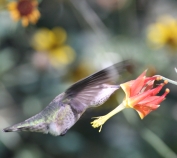Columbine pollination success not determined by a proteinaceous reward to hummingbird pollinators
DOI:
https://doi.org/10.26786/1920-7603(2017)fiveAbstract
Plants provision pollinators with a variety of nutritious or otherwise beneficial rewards. Hummingbirds (primarily Calypte anna) pollinate the columbine Aquilegia eximia. In addition to drinking nectar, they glean entrapped insects from its sticky surfaces. To test the hypothesis that this insect carrion, an abundant and easily-collected protein source, serves as a provision to the pollinator and increases pollination I experimentally manipulated this reward and measured pollination success. I set up three treatments - an insect carrion addition, carrion removal, and an unmanipulated control - on small patches of the plant in each of five populations of A. eximia. Pollination success, measured by seed set in emasculated flowers, was unaffected by carrion level. Pollination success positively correlated with average floral display in each patch; this suggests that local nectar reward in an area is more important than this proteinaceous reward in determining pollination success. Stickiness in this system may function as an effective exclusion mechanism for smaller-bodied pollinators. While this study did not demonstrate that captured insects increased reproductive success of this columbine, this interaction (and pollinator exclusion) may play a role in other hummingbird-plant interactions, as hummingbird pollination and insect-entrapment occur together in at least nine species of six plant families.

Downloads
Published
How to Cite
Issue
Section
License
Copyright (c) 2017 Eric LoPresti

This work is licensed under a Creative Commons Attribution 4.0 International License.
JPE is an open access journal which means that all content is freely available without charge to the user or his/her institution.
Authors who publish with this journal agree to the following terms:
1) Authors retain copyright and grant the journal right of first publication with the work simultaneously licensed under a Creative Commons Attribution License that allows others to share the work with an acknowledgement of the work's authorship and initial publication in this journal.
2) Authors are able to enter into separate, additional contractual arrangements for the non-exclusive distribution of the journal's published version of the work (e.g., post it to an institutional repository or publish it in a book), with an acknowledgement of its initial publication in this journal.
3) Authors are permitted and encouraged to post their work online (e.g., in institutional repositories or on their website) prior to and during the submission process, as it can lead to productive exchanges, as well as earlier and greater citation of published work (See The Effect of Open Access).
To assure a broader targeted audience, content will be included into databases (such as EBSCO) and directories (such as DOAJ).











